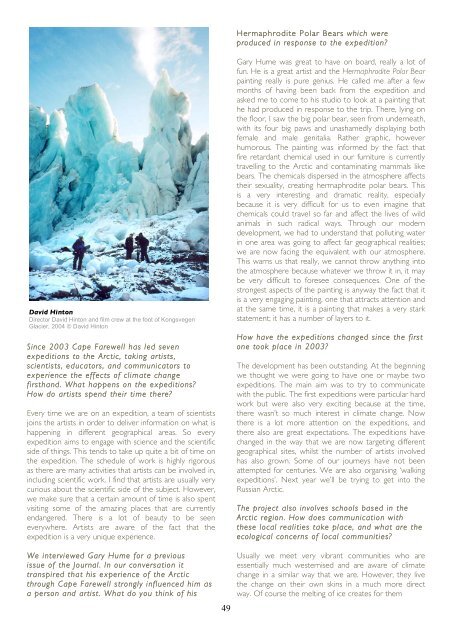M - Antennae The Journal of Nature in Visual Culture
M - Antennae The Journal of Nature in Visual Culture
M - Antennae The Journal of Nature in Visual Culture
You also want an ePaper? Increase the reach of your titles
YUMPU automatically turns print PDFs into web optimized ePapers that Google loves.
David H<strong>in</strong>ton<br />
Director David H<strong>in</strong>ton and film crew at the foot <strong>of</strong> Kongsvegen<br />
Glacier, 2004 � David H<strong>in</strong>ton<br />
S<strong>in</strong>ce 2003 Cape Farewell has led seven<br />
expeditions to the Arctic, tak<strong>in</strong>g artists,<br />
scientists, educators, and communicators to<br />
experience the effects <strong>of</strong> climate change<br />
firsthand. What happens on the expeditions?<br />
How do artists spend their time there?<br />
Every time we are on an expedition, a team <strong>of</strong> scientists<br />
jo<strong>in</strong>s the artists <strong>in</strong> order to deliver <strong>in</strong>formation on what is<br />
happen<strong>in</strong>g <strong>in</strong> different geographical areas. So every<br />
expedition aims to engage with science and the scientific<br />
side <strong>of</strong> th<strong>in</strong>gs. This tends to take up quite a bit <strong>of</strong> time on<br />
the expedition. <strong>The</strong> schedule <strong>of</strong> work is highly rigorous<br />
as there are many activities that artists can be <strong>in</strong>volved <strong>in</strong>,<br />
<strong>in</strong>clud<strong>in</strong>g scientific work. I f<strong>in</strong>d that artists are usually very<br />
curious about the scientific side <strong>of</strong> the subject. However,<br />
we make sure that a certa<strong>in</strong> amount <strong>of</strong> time is also spent<br />
visit<strong>in</strong>g some <strong>of</strong> the amaz<strong>in</strong>g places that are currently<br />
endangered. <strong>The</strong>re is a lot <strong>of</strong> beauty to be seen<br />
everywhere. Artists are aware <strong>of</strong> the fact that the<br />
expedition is a very unique experience.<br />
We <strong>in</strong>terviewed Gary Hume for a previous<br />
issue <strong>of</strong> the <strong>Journal</strong>. In our conversation it<br />
transpired that his experience <strong>of</strong> the Arctic<br />
through Cape Farewell strongly <strong>in</strong>fluenced him as<br />
a person and artist. What do you th<strong>in</strong>k <strong>of</strong> his<br />
49<br />
Hermaphrodite Polar Bears which were<br />
produced <strong>in</strong> response to the expedition?<br />
Gary Hume was great to have on board, really a lot <strong>of</strong><br />
fun. He is a great artist and the Hermaphrodite Polar Bear<br />
pa<strong>in</strong>t<strong>in</strong>g really is pure genius. He called me after a few<br />
months <strong>of</strong> hav<strong>in</strong>g been back from the expedition and<br />
asked me to come to his studio to look at a pa<strong>in</strong>t<strong>in</strong>g that<br />
he had produced <strong>in</strong> response to the trip. <strong>The</strong>re, ly<strong>in</strong>g on<br />
the floor, I saw the big polar bear, seen from underneath,<br />
with its four big paws and unashamedly display<strong>in</strong>g both<br />
female and male genitalia. Rather graphic, however<br />
humorous. <strong>The</strong> pa<strong>in</strong>t<strong>in</strong>g was <strong>in</strong>formed by the fact that<br />
fire retardant chemical used <strong>in</strong> our furniture is currently<br />
travell<strong>in</strong>g to the Arctic and contam<strong>in</strong>at<strong>in</strong>g mammals like<br />
bears. <strong>The</strong> chemicals dispersed <strong>in</strong> the atmosphere affects<br />
their sexuality, creat<strong>in</strong>g hermaphrodite polar bears. This<br />
is a very <strong>in</strong>terest<strong>in</strong>g and dramatic reality, especially<br />
because it is very difficult for us to even imag<strong>in</strong>e that<br />
chemicals could travel so far and affect the lives <strong>of</strong> wild<br />
animals <strong>in</strong> such radical ways. Through our modern<br />
development, we had to understand that pollut<strong>in</strong>g water<br />
<strong>in</strong> one area was go<strong>in</strong>g to affect far geographical realities;<br />
we are now fac<strong>in</strong>g the equivalent with our atmosphere.<br />
This warns us that really, we cannot throw anyth<strong>in</strong>g <strong>in</strong>to<br />
the atmosphere because whatever we throw it <strong>in</strong>, it may<br />
be very difficult to foresee consequences. One <strong>of</strong> the<br />
strongest aspects <strong>of</strong> the pa<strong>in</strong>t<strong>in</strong>g is anyway the fact that it<br />
is a very engag<strong>in</strong>g pa<strong>in</strong>t<strong>in</strong>g, one that attracts attention and<br />
at the same time, it is a pa<strong>in</strong>t<strong>in</strong>g that makes a very stark<br />
statement; it has a number <strong>of</strong> layers to it.<br />
How have the expeditions changed s<strong>in</strong>ce the first<br />
one took place <strong>in</strong> 2003?<br />
<strong>The</strong> development has been outstand<strong>in</strong>g. At the beg<strong>in</strong>n<strong>in</strong>g<br />
we thought we were go<strong>in</strong>g to have one or maybe two<br />
expeditions. <strong>The</strong> ma<strong>in</strong> aim was to try to communicate<br />
with the public. <strong>The</strong> first expeditions were particular hard<br />
work but were also very excit<strong>in</strong>g because at the time,<br />
there wasn’t so much <strong>in</strong>terest <strong>in</strong> climate change. Now<br />
there is a lot more attention on the expeditions, and<br />
there also are great expectations. <strong>The</strong> expeditions have<br />
changed <strong>in</strong> the way that we are now target<strong>in</strong>g different<br />
geographical sites, whilst the number <strong>of</strong> artists <strong>in</strong>volved<br />
has also grown. Some <strong>of</strong> our journeys have not been<br />
attempted for centuries. We are also organis<strong>in</strong>g ‘walk<strong>in</strong>g<br />
expeditions’. Next year we’ll be try<strong>in</strong>g to get <strong>in</strong>to the<br />
Russian Arctic.<br />
<strong>The</strong> project also <strong>in</strong>volves schools based <strong>in</strong> the<br />
Arctic region. How does communication with<br />
these local realities take place, and what are the<br />
ecological concerns <strong>of</strong> local communities?<br />
Usually we meet very vibrant communities who are<br />
essentially much westernised and are aware <strong>of</strong> climate<br />
change <strong>in</strong> a similar way that we are. However, they live<br />
the change on their own sk<strong>in</strong>s <strong>in</strong> a much more direct<br />
way. Of course the melt<strong>in</strong>g <strong>of</strong> ice creates for them












